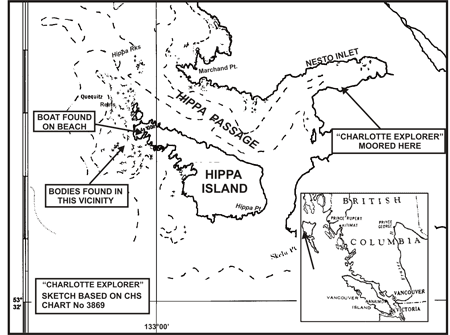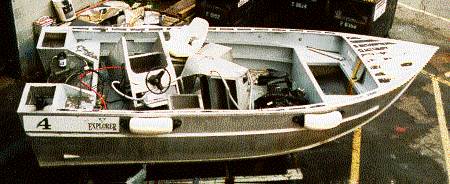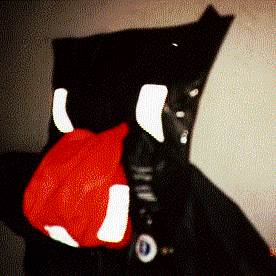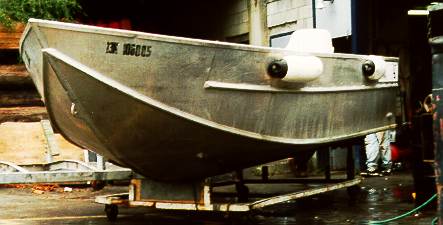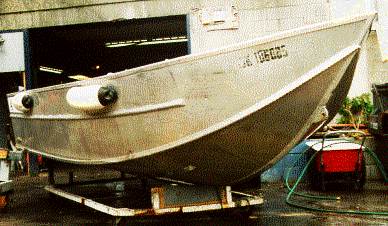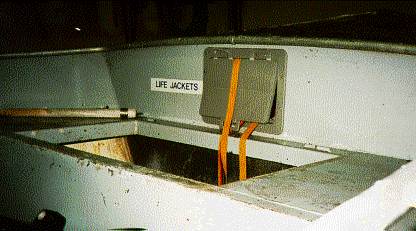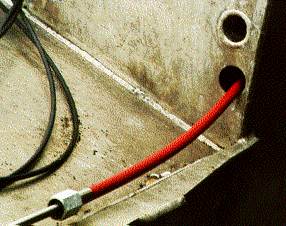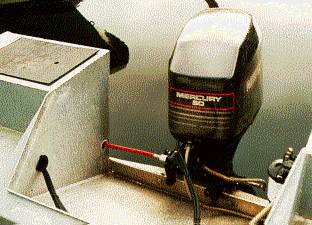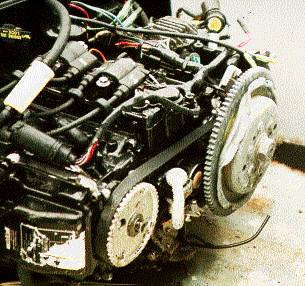Capsizing
Small Boat "CHARLOTTE EXPLORER 4"
North-west of Hippa Island
Queen Charlotte Islands, British Columbia
The Transportation Safety Board of Canada (TSB) investigated this occurrence for the purpose of advancing transportation safety. It is not the function of the Board to assign fault or determine civil or criminal liability. This report is not created for use in the context of legal, disciplinary or other proceedings. See Ownership and use of content. Masculine pronouns and position titles may be used to signify all genders to comply with the Canadian Transportation Accident Investigation and Safety Board Act (S.C. 1989, c. 3).
Summary
The "CHARLOTTE EXPLORER 4" (CE4) and its two occupants were declared overdue when the small boat did not return to the mother ship "CHARLOTTE EXPLORER" on the evening of 12 September 1995. A search initiated by the crew of the mother ship using other small craft continued throughout the night. At dawn, more boats and a helicopter joined the search. The "CE4" was found upside down on a beach on the north-west corner of Hippa Island. Soon afterward, the crew of the helicopter sighted the bodies of the small boat's two occupants in a kelp bed just off the coast.
The Board determined that the chartered "CE4", while fishing alone with the outboard motor most likely stopped, capsized after drifting into an area of kelp and rocks where a combination of tide and sea swell was locally creating large waves of up to, or larger than, seven metres with breaking crests. The charter company's procedures with regard to fishing alone, maintaining regular radio contact and patrols to ensure the safety of its guests were not enforced. There was delay in determining that the small boat was overdue and in starting a search. As there was no witness, the exact location, time and cause of the capsizing could not be determined.
1.0 Factual Information
1.1 Particulars of the Vessels
| "CHARLOTTE EXPLORER 4" | "CHARLOTTE EXPLORER" | |
|---|---|---|
| Official number | 13K106085 | 810531 |
| Port of registry | Vancouver, B.C.Footnote 1 | Vancouver, B.C. |
| Flag | Canada | Canada |
| Gross TonsFootnote 2 | N/A | 821 |
| Net Tons | N/A | 436 |
| Length | 5.18 m | 52.73 m |
| Crew | 2 | 15 |
| Built | 1993, Port Coquitlam, B.C. | 1966, Jefferson, Indiana, USA |
| Owners | Sewells Marine Group Horseshoe Bay, B.C. | B5000 Holdings Ltd. West Vancouver, B.C. |
1.1.1 Description of the Vessels
The "CHARLOTTE EXPLORER 4" (CE4) is an aluminium open boat with two midships consoles, powered by an outboard motor controlled and steered from the starboard console. The hull is of shallow-vee, single-chine form and incorporates a sealed double-bottom, bow and stern buoyancy compartments (see Appendix E, Photograph 1). There is a storage compartment in the bow, with a door, where the lifejackets are stowed. Abaft the bow compartment is a fish bin for storing the catch, which has separate self-draining holes. The cockpit is also self-draining through drains in each aft quarter.
The "CHARLOTTE EXPLORER" is a converted seismic vessel with the wheel-house forward. The accommodation runs the full length of the main deck and the forward two thirds of the upper deck. The after part of the upper deck is open and used for storing the small boats during transit to and from the Queen Charlotte Islands. When on station in the Queen Charlottes, the vessel acts as the mother ship for 18 small aluminium open boats and as a hotel for the guests.
1.2 History of the Voyage
Tuesday, 12 September 1995, was the penultimate day of the vessel's fishing season before the "CHARLOTTE EXPLORER" returned to her winter berth in Vancouver, B.C.
Two guests, a man and a woman both 76 years old, departed the "CHARLOTTE EXPLORER" between 0700Footnote 3 and 0730 on board the "CE4" which had been assigned to them for the duration of their fishing trip. By means of the boat's very high frequency (VHF) radio, they made radio contact with the "morning fish master" on channel 69. They then proceeded from the anchorage in Nesto Inlet to the north-western side of Hippa Island, where they were seen fishing off the kelp beds during the morning.
There were eight small boats with guests and one small boat with crew aboard out on the water. Seven of the remaining small boats had been stripped ready for the return to Vancouver. The morning fish master, who patrols the fishing areas and assists the guests as required, saw the "CE4" among a group fishing on the south side of the north-west corner of Hippa Island. After the fish master saw the "CE4" and spoke to its occupants by radio around noon, no one recalls seeing it again.
During the morning, the morning fish master noted that the tide was tending to push the boats away from the island. He also noted that there were breakers of up to seven metres in height in the vicinity of the north-west tip of Hippa Island. He expected the tide to turn and start pushing the boats toward the island after lunch. He went off duty at 1300, and was relieved by the "afternoon fish master".
The custom aboard the "CHARLOTTE EXPLORER" was to keep a tight check on the whereabouts of guests in inclement weather. As the weather was good on the day of the occurrence, the afternoon fish master did not get a complete hand-over briefing. When he and a guest left the "CHARLOTTE EXPLORER" on his boat, there were three guest boats at the dock. He did not carry out a complete check of the other boats by radio, but went out to patrol and fish with the guest. He headed out of the west entrance of Hippa Passage and around the north of Hippa Island, to where the morning fish master had said the guest boats were fishing. When he arrived off the lighthouse point of Hippa Island, there were no guest boats there. He remained at the point and fished outside the kelp.
The afternoon fish master spoke to some of the guests by radio during the afternoon, but not with the occupants of the "CE4". It was only when he moved down to the south end of Hippa Passage to fish, at about 1600, that the fish master first sighted one of the other boats (the "CHARLOTTE EXPLORER 12"). It was at the south-west corner of Hippa Island; there were five other boats in the area as well.
At approximately 1730, the afternoon fish master received a radio message that a crew boat that was fishing at the south pass was returning to the mother ship. At this time, he thought all the boats were accounted for, with five guest boats fishing around the south pass and the three guest boats that were at the ship when he left earlier. He assumed that these three guest boats were still at the ship as he had received no radio message indicating that any had returned to the fishing grounds during the afternoon.
The afternoon fish master fished with the guest until 1800 or 1830 and then returned to the "CHARLOTTE EXPLORER" via the southern entrance to Hippa Passage. During his return, he saw five boats, three in the southern passage and two on the north side of the island. Upon entering Nesto Inlet, he saw several boats clustered together at the head of the inlet while the occupants watched a bear and cubs on shore.
One of the boats had grounded on the falling tide, and the fish master unsuccessfully tried to tow it off. Leaving the grounded boat to be dealt with later, he took its occupants on board his boat and returned them to the mother ship. After returning to the "CHARLOTTE EXPLORER" at approximately 2015, he did a boat count and discovered that one boat (the CE4) was missing.
The afternoon fish master notified the morning fish master that a boat was missing, then took his boat back out to Marchand Point in Hippa Passage to try to contact the "CE4" by VHF radio. There are several localized radio reception problem areas; the mother ship could not always reach the boats out on the water. Depending on their location, the fish masters on patrol outside Nesto Inlet often could make radio contact even with the much smaller sets in their boat.
When the fish master received no reply from the missing boat, he notified the corporate representative, who is the liaison between the guests, the ship's master, the fish masters and the vessel's crew. A search was commenced at 2035.
The search, under the direction of the corporate representative and the master, continued throughout the night until the missing boat was sighted on a beach at 0800 on 13 September 1995.
1.3 Injuries to Persons
| Crew | Passengers | Others | Total | |
|---|---|---|---|---|
| Fatal | - | 2 | - | 2 |
| Missing | - | - | - | - |
| Serious | - | - | - | - |
| Minor/None | - | - | - | - |
| Total | - | 2 | - | 2 |
Autopsies determined that the cause of death of both occupants of the "CE4" was by drowning.
1.4 Search and Rescue Operation
The crew of the "CHARLOTTE EXPLORER" commenced the search at 2035 on 12 September 1995, after the afternoon fish master had tried unsuccessfully to make radio contact with the "CE4", from outside the entrance to Nesto Inlet.
At 2035, three boats operated by crew from the "CHARLOTTE EXPLORER" were dispatched to different locations to search: one to Skelu Bay, a second to Athlow Bay, and the third to the west side of Hippa Island. The search areas were based on information other guests on the "CHARLOTTE EXPLORER" had given the corporate representative, that the "CE4" guests had said the previous evening they were going to try Athlow Bay. No one involved in the initial search was aware that the morning fish master had seen the "CE4" at the lighthouse point on Hippa Island at noon.
The boats completed this initial search at 2330. As nothing was found, the master informed Prince Rupert Coast Guard Radio Station (CGRS) of the situation at that time. The CGRS made a Marine Information Broadcast (MIB) requesting vessels in the area to keep a look-out for the missing boat. It also contacted the Rescue Co-ordination Centre (RCC) in Esquimalt, B.C., to initiate the search and rescue (SAR) response.
The crew of the "CHARLOTTE EXPLORER" continued the search in the vessel's boats throughout the night. The master contacted two local airline companies to order a helicopter and a fixed-wing aircraft to assist with the search after dawn. Meanwhile, RCC Esquimalt arranged for a Buffalo aircraft to fly to the scene and for a Canadian Coast Guard (CCG) Sikorsky helicopter to leave Prince Rupert, B.C., at dawn to aid in the search.
At 0640 on 13 September, the Buffalo was in Sandspit, B.C., refuelling for the search, and at 0650, the search areas for the boats were determined in consultation between the helicopters and the "CHARLOTTE EXPLORER". The boats, including several operated by guests, left the mother ship at 0720, and all were on station ready to start searching by 0745.
At 0755, the morning fish master saw an overturned boat ashore, at the north-west end of Hippa Island, just south of the lighthouse. By 0810, he had confirmed that the overturned boat was the "CE4"; the search for persons in the water continued. Two people from the "CHARLOTTE EXPLORER" were landed and conducted a shoreline search in both directions from the stranded boat. More people from the mother ship landed and began the work of recovering the boat.
The Buffalo aircraft, the Sikorsky helicopter and the boats continued searching. At 1015, a body was sighted in the kelp approximately 250 metres west-south-west of the stranded boat, and at 1045, a second body was sighted nearby in the same kelp bed. Crew boats retrieved both bodies. Both victims were wearing Mustang Type 1800, fisherman's marine anti-exposure and flotation suits, consisting of a jacket and high-bib trousers.
To provide extra support, the Mustang suit has an inflatable collar which the wearer can inflate by blowing into a tube. The man had not inflated the collar on his suit. The woman had managed to inflate her collar partially, approximately 15 per cent by volume (see Appendix E, Photograph 2), but not enough to make a significant difference to her support in the water. Both victims had either lost or shed their rubber boots while in the water.
After recovering the bodies, it was noticed that several pieces of equipment from the boat were in the water between the beach where the boat was found and the location of the victims' bodies.
1.5 Damage to the Boat
The "CE4" was found on the beach extensively damaged. (See also Section 1.11.)
1.6 Location of the Boat's Equipment
Some of the loose equipment was seen in the kelp bed offshore from the beach where the boat was discovered. One of the pieces of equipment found was a halibut harpoon and its plastic float.
1.7 Certification
The "CE4" has a Transport Canada Small Craft Decal and has type approval.
The "CHARLOTTE EXPLORER" was certificated in accordance with the Canada Shipping Act for the trade in which she was engaged and for the area of operations.
1.8 Personnel History
1.8.1 Guests
Both guests were elderly American citizens.
The man had many years' experience of sport sea fishing and had enjoyed a successful fishing trip to the Queen Charlotte Islands the previous year on the "CHARLOTTE EXPLORER". It was reported, however, that while his fishing experience was great, his experience of small boat handling was limited.
The woman, a long-time friend of the man, had little or no experience of sea fishing and no boat handling experience at all.
1.8.2 Officers and Crew Members
The master of the "CHARLOTTE EXPLORER" holds a Canadian Master Mariner's Certificate. He has been the master of the vessel for four years, engaged in the same trade.
The morning fish master has been so employed for four years. Prior to this, he was a deck-hand for three years. He has no marine certificates, nor are such certificates required for the duties he performed.
The afternoon fish master has four years' experience as a commercial fisherman and a further four years as a sport fishing guide. He had joined the "CHARLOTTE EXPLORER" as a fish master two years earlier. He has no marine certificates, nor are such certificates required for the duties he performed.
The corporate representative is the president of the company, which he represents during his tours of duty on board the "CHARLOTTE EXPLORER". He has 40 years' experience in marina and tourist operations within his family business, of which this operation is a part. He has no formal marine certificates, nor are such certificates required for the duties he performed.
1.9 Weather and Tidal Information
Environment Canada has two recording stations in the area. The Kindakun Rocks weather station is 15 miles SSE of Hippa Light and the West Moresby buoy is 63 miles south of Hippa Light. The Kindakun Rocks station is equipped to record air temperature and pressure, as well as wind speed and direction, while the West Moresby buoy is equipped to record air temperature, wave height, wave period, maximum wave height, wind direction, wind speed and wind gusts.
Hippa Island, Kindakun Rocks and West Moresby buoy generally all experience the same weather as they are all open to the Pacific Ocean.
On 12 September 1995, for the period 0628 to 2328, Kindakun Rocks recorded air temperatures between 13 and 15°C and wind speeds between two and nine knots generally from the north or north-west.
For the same time period, the buoy at West Moresby recorded air temperatures ranging from 15 to 16°C, with winds from 4 to 10 knots generally from the north or north-west. The wave heights were between 2 and 3.6 m, with maximum waves peaking at 7 m at 1335. The wave periods were in excess of 11 seconds, indicating that the waves were ocean swells. Wind-generated waves in the area have a period of between four and nine seconds.
The tides at Port Louis, 10 miles north of Hippa Island, and referenced on Tofino, on 12 September 1995, were predicted to be 1.188 m above chart datum at 1008, and 3.993 m at 1607.
The Sailing Directions for the British Columbia Coast (North Portion) note that: "Foul ground surrounds Hippa Island. Quequitz Reefs, an area of drying and sunken rocks, are west of Hippa Island and a shoal finger extends NW from the islets off the NW end of the island."
1.10 Stability of the Boat
The "CE4" is designed to be very stable. One of the owners' requirements was that, in moderate weather, three people could stand on one side of the boat and haul a 90- to 120-kilogram halibut aboard, without immersing the gunwale.
1.11 Condition of the Boat after Recovery
Inspection of the "CE4" on the beach revealed that both consoles had been ripped off. These were also found ashore, nearby. Both seats behind the consoles were badly damaged. The outboard motor cover was missing; it was not recovered. At the top of the outboard motor, the flywheel and starter ring gear were damaged (see Appendix E, Photograph 8). The motor was switched off, the gear lever was in the neutral position, and there was no indication that the propeller had been fouled by kelp. The bottom of the boat (see Appendix E, Photographs 3 and 4) showed no signs of grounding damage.
Both lifejackets were found, stowed in the bow locker (see Appendix E, Photograph 5), but all loose gear was missing from the boat. Some of this gear was found between the location of the victims' bodies and that of the stranded boat.
The VHF radio was still in place in one of the consoles, switched on and tuned to the frequency used for communication, VHF channel 69.
Some time prior to this accident, the integrity of the starboard aft buoyancy tank built into the transom of the boat had been breached in order to feed a new steering control cable through the body of the tank. Ideally, this cable should have been fed through the pipe fitted for that purpose (see Appendix E, Photograph 6).
1.12 Responsibilities and Duties of the Crew of the "CHARLOTTE EXPLORER"
The master has overall responsibility for the vessel and the small boats used by the guests. During the day, he maintains a radio listening watch and supervises the crew on board the vessel.
The corporate representative is responsible for the co-ordination between the "CHARLOTTE EXPLORER" and guest fishing activities. He spends some time out on the water and some time on board the mother ship.
The fish masters are required to ensure the safety of all guests, to scout fish locations, to experiment with new techniques, and to lend assistance to individual guests requiring help catching or landing big fish. Corporate literature indicates that the safety of guests is the fish masters' paramount duty.
The back-deck crewmen keep the boats refuelled and re-supplied with bait when the guests are back on board. They meet the guests and prepare the fish caught for shipping when the guests depart for home. They normally see the guests off when they go fishing.
1.13 Operation of the "CHARLOTTE EXPLORER" and the Small Boats During Guest Fishing Activities
The "CHARLOTTE EXPLORER" is moored, perpendicular to the beach, with two bow anchors out and stern lines to the beach on the south side of Nesto Inlet. A floating dock is constructed alongside the vessel. The small boats are tied up to the floating dock when they are not being used.
During the night, engineers check the boats' outboard motors and radios. The night back-deck crewman checks each boat to ensure that it is ready for the next day and stocked with fishing gear, bait and fuel.
In the early morning, at a time that they choose, guests depart in their boat to fish. There is no time set to return to the mother ship.
The back-deck crewman asks guests to check in by radio but not all of them do so. While out on the water, the guests are requested to buddy-up with another boat and to contact the fish master by radio to advise of their whereabouts during the day.
The morning fish master departs at daylight and stays out until approximately 1300 when he hands over to the afternoon fish master who stays out until sunset. During the day, the fish masters patrol the area, talk to guests by radio and assist them when necessary. There is no scheduled radio reporting regime in place for boats to report their whereabouts. Both fish masters use the same boat and equipment; normally only one is on the water at a time.
When guests return to the mother ship, they hand over their catch to the back-deck crewman on duty for processing. They may also arrange with him to have photographs taken with big fish.
1.14 Information Provided to the Guests on Safety, Boat Operation and the Area
1.14.1 Before Boarding the "CHARLOTTE EXPLORER"
During the fishing season, guests are flown in from Vancouver to Nesto Inlet on a twice-weekly basis. On the flight to the Queen Charlotte Islands, all guests are given a small information booklet to read. It deals, in brief, with such topics as what to do "When You Arrive", "Your Boats", various fishing topics, "Safety First!!!", "Fish Master's Role", and various items about the catch and the crew's role. (See Appendix B.)
The booklet stresses the remoteness of the area, the rapidity of change in the weather, the importance of the "buddy system" and of keeping in radio contact if fishing alone.
1.14.2 On Board the "CHARLOTTE EXPLORER"
The guests are assembled in the upper lounge and are given a three-part introduction into the arrangements on board the "CHARLOTTE EXPLORER", and fishing techniques and areas. They then don Mustang 1800 suits and are given a practical demonstration of the small boats they will be using.
Each boat is assigned to a particular group of fishers for the duration of their stay. All 16 boats are then taken, together, for a test run in Nesto Inlet. During this test run, at least three people from the company are with the guests to observe and assess their boat handling capability and to identify those guests who require more training.
Guests who are identified as requiring more hands-on training in boat operation are given such training before they are allowed to go out on their own.
1.14.3 In the Small Boats
On board every boat, there is a plasticized information book entitled Your "On the Water" Companion (see Appendix C).
The centre pages are reduced copies of the Canadian charts of the area. One of these is chart No. 3860, Hippa Island section, and the other is a section of chart No. 3869 showing the west coast of Graham Island from Hosu Cove to Seal Point and includes Hippa Island.
The book gives the location of the boat's safety equipment and advises guests to familiarize themselves with it. The fact that the boats operate in a remote area is again pointed out as is the advantage of the "buddy system". The importance of maintaining radio contact, the observance of good seamanship and of personal responsibility are stressed.
1.14.4 Notices Attached to the Boat
Attached to the "CE4" in prominent places are clear and legible notices in black print on a white background. These notices reiterate The Boater's Responsibility Code and Safety, give advice on seamanship, instructions for the proper use of the radio, starting instructions for the motor, and indicate the stowage of life-saving equipment.
1.15 Charter Vessel Operation and Regulations
The vessel was operating as a mother ship or lodge for small boat private fishing trips and was secured to the beach. As such, she did not require a full marine complement. Most vessels reduce the number of deck crew in favour of persons working to maintain the small boats and to clean and pack the fish caught by the fee-paying guests.
There are no regulations governing the operations of small charter vessels once the mother ship is secured in her seasonal position. The industry is self-monitoring.
The small boats have to comply with the Small Vessel Regulations made pursuant to the Canada Shipping Act regarding the equipment which must be carried on board. The "CE4" was fully and properly equipped.
Guests are not required by the operators of the mother ship to have a current radio licence, even though most of the boats in use are fitted with radios which the guests are expected and encouraged to use for safety communications and to maintain contact with other boats and the mother ship. Guests are not required to report medical conditions or navigational skills before arrival on site.
One or two fish masters are normally employed to look after the guests, but the guests are allowed to take out small boats without direct supervision of their activities or whereabouts.
2.0 Analysis
2.1 Charter Company's Safety Information for Guests
The content and quality of the safety information contained in the booklets given to the guests and of the reminders posted on each boat show that the charter company takes seriously its obligation to inform guests on matters relating to their safety while on board the mother ship or when out fishing.
2.2 Charter Company's Safety Procedures - Radio
Although the importance of maintaining radio contact is stressed in the safety information given to guests, there was no scheduled radio reporting regime in place. As a result, it was not discovered until long after the fact that the "CE4" may have been in difficulty.
Because there does not appear to have been any great stress on the utility of a regular reporting regime and the correct use of the VHF radio, the guests did not, in the main, comply with the instructions of several members of the crew to report regularly. However, the instructions on radio use, posted on the boat, were clear and unequivocal.
2.3 Charter Company's Safety Procedures - "The Buddy System"
According to the "Fish Master's Role" section of the company's in-flight information booklet, the fish master's paramount duty is to ensure the safety of all guests. His first priority, after safety, is to ensure that guests maximize their catch.
While the safety information emphasizes the advantages of the "buddy system" and the dangers of fishing alone, a system to ensure compliance was not enforced by the corporate representative, the master or the fish masters.
Because the "buddy system" was not enforced for those guests fishing away from the main areas, the "CE4" was not seen after noon. No one was aware of the capsizing, which went unwitnessed and unnoticed until a physical check of boats was made at about 2015.
2.4 Fish Master's Duties
The secondary duty of the fish master, to assist guests to maximize their catch, appears to have conflicted with the paramount duty of ensuring the guests' safety. Neither the master nor the corporate representative insisted that the fish masters patrol and sight all the guests or boats on a regular basis during either the morning or afternoon watches.
2.5 Charter Company's Safety Procedures - Watch Hand-overs
When the weather was good, the practice on board was that the morning fish master did not give a full and detailed hand-over report to the afternoon fish master. Consequently, the afternoon fish master did not carry out a complete visual and radio check of the guests and their whereabouts, but set out to go fishing with one of the guests.
Because the good weather relaxed the vigilance of both fish masters, the safety overview of the guests' whereabouts was correspondingly reduced. Although he spoke to some of the guests during the afternoon, the afternoon fish master did not see another boat until approximately 1600. The effect of not carrying out patrols or comprehensive radio checks was that no one was aware that the "CE4" was missing until after the time it should have returned to the mother ship.
2.6 Stability of the "CHARLOTTE EXPLORER 4"
From the outset, the charter company had attempted to ensure that the small fishing boats were stable for their purpose and intended use. The stability of the boat was such that, in moderate weather, three people could stand on one side to haul a 120-kilogram fish aboard, without immersing the gunwale.
However, the "CE4" may have been overwhelmed by a wave or swell, or a combination of both, which exceeded the boat's design capability. Such a combination was possible given the sea conditions known and observed to have existed in the vicinity of the north-west corner of Hippa Island on the day of the accident.
While the breach of the integrity of the starboard aft buoyancy tank would have reduced the buoyancy aft if it became flooded, the tank is not large and the loss of buoyancy would not have been a crucial or a significant factor contributing to the accident. If one occupant was attempting to rescue the other person over the transom, the tank may have had some effect on the operation.
2.7 Condition of the Recovered Boat
The settings of the controls, as found, indicated that the outboard motor had been taken out of gear. However, because the console to which the controls were fixed had been ripped off the boat, the control lever may not have been in the neutral position when the boat was overwhelmed. Although it is less likely, a similar situation may exist with regard to the position of the on/off switch. As a result, no positive inference as to the position of the controls at the time of the accident may be drawn.
2.8 Indications that the "CHARLOTTE EXPLORER 4" Capsized
Because there was neither a witness to the tragedy nor a survivor, the precise sequence of events is unknown. There is, however, evidence which points to the "CE4" having capsized offshore of the kelp bed where it was last seen fishing.
The indications that the "CE4" capsized were that the damage to the consoles and seats and to the top of the outboard motor was consistent with that which would be caused by a capsized boat grounding on the beach (see Appendix E, photographs 1 and 8); and that the bottom of the boat (see Appendix E, photographs 3 and 4) showed no signs of grounding damage.
Because there was no sign of kelp on the motor or in the propeller when the boat was recovered, it is likely that the boat capsized offshore of the kelp where it had been seen and where large swells were measured that day. Further, some of the loose equipment was seen in the kelp bed offshore from the beach where the boat was discovered. One piece of equipment in particular was the halibut harpoon and its plastic float. Its normal location and stowage are such that the boat would have to have been capsized for the harpoon to fall out.
All indications are that the "CE4" capsized offshore of the kelp bed near the beach where it was later found.
2.9 Cause of the Capsizing
The sequence of events leading to the capsizing is unknown.
While the male guest had satisfied the crew of the "CHARLOTTE EXPLORER" that he could handle the "CE4" while in Nesto Inlet, he may not have had sufficient boat handling experience to appreciate the danger of the effect of the rocks and foul ground on the heavy swells north-west of Hippa Island. Because the female guest did not have sea fishing or boat handling experience, it is likely that she relied on the male guest's greater knowledge of the area.
The motor may have stalled or it may have been switched off while the boat's occupants were preoccupied fishing or landing a fish. There is also a possibility that the motor cowling had been removed to inspect or repair the motor.
Alternatively, one of the guests may have accidentally fallen overboard while fishing in the heavy swell. The motor may have been stopped by the other to attempt a recovery over the lowest part of the transom, adjacent to the motor. During any such rescue attempt, it would not have been possible to manoeuvre the boat.
With the motor stopped, the boat's occupants would not have had the ability to manoeuvre clear of areas of danger in the foul ground off Hippa Island. It is most likely that the boat drifted on the tide into this area of confused and breaking swells, and capsized.
The lack of bottom damage to the boat indicates that it did not capsize as a result of having grounded on the rocks in the area.
2.10 Search and Rescue
The guests in the "CE4" were not missed until after the time they should have been back at the mother ship, but once it was determined that the boat was missing, the master and the corporate representative quickly organized an exhaustive search of the immediate area. However, because the CGRS was not called until after the initial search was unsuccessful, the main RCC-directed search was not launched until the next morning.
3.0 Findings
3.1 Findings
- The guests on board the "CHARLOTTE EXPLORER 4" (CE4) were fishing in the vicinity of the kelp bed on the north-west corner of Hippa Island.
- The area in which the guests were fishing is foul ground around which the ocean swell increases in height, breaks and causes heavy confused seas.
- The sea swell increased during the day and peaked at about 1330, when a maximum wave height of seven metres was recorded at the weather buoy.
- Prior to being allowed to fish away from the group, guests were not adequately screened to determine their level of experience of the marine environment and boat handling.
- The guests may not have had the boat handling experience to deal with the conditions encountered when increasing swells and tidal forces pushed their boat toward the rocks and kelp bed.
- The motor was most likely stopped by one of the guests prior to the boat capsizing.
- Guests fishing away from the main areas did not use the "buddy system" and its use was not enforced by the corporate representative, the master or the fish masters.
- Although the importance of maintaining radio contact is stressed in the safety information given to guests, there was no scheduled radio reporting regime in place.
- Neither the master nor the corporate representative insisted that the fish masters patrol and sight all the guests or boats on a regular basis.
- The secondary duty of the fish masters, to assist guests to maximize their catch, appears to have conflicted with the paramount duty of ensuring the guests' safety.
- The charter company's procedures, as set out in the safety information given to guests, were neither followed by the victims nor enforced by the company at the operational level.
3.2 Causes
The chartered "CE4", while fishing alone with the outboard motor most likely stopped, capsized after drifting into an area of kelp and rocks where a combination of tide and sea swell was locally creating large waves of up to, or larger than, seven metres with breaking crests. The charter company's procedures with regard to fishing alone, maintaining regular radio contact and patrols to ensure the safety of its guests were not enforced. There was delay in determining that the small boat was overdue and in starting a search. As there was no witness, the exact location, time and cause of the capsizing could not be determined.
4.0 Safety Action
4.1 Safety Concern
In its investigations, the Board continues to find that there are safety shortcomings with small passenger and charter vessel operations. The Board has recommended stronger regulatory oversight to offset shortcomings in the management of the small companies engaged in these largely tourist operations. In addition, the Board has observed that efforts may be warranted to increase public awareness of necessary safety provisions for such operations.
To date, the Board's work has not revealed to what degree the risks observed in the industry as a whole are present within the wilderness fishing or fishing lodge segment of the charter industry. Certainly, the investigation into the capsizing of the "CHARLOTTE EXPLORER 4" indicates that practices such as a "buddy system" and scheduled radio check-ins would eliminate some of the risks. In this unique industry, the operator and the client must rely on each other and systems will be effective only where the operator and client work together to ensure that safe practices are understood and followed.
The Board recognizes the diverse nature of the industry, but given the safety issues identified in tourist charter operations in Canada and the specific concerns raised by this investigation, the Board is of the opinion that practices within the wilderness fishing industry as a whole bear further review. Transport Canada, the Canadian Coast Guard and the industry are those best placed to co-operate in an examination of current practices and to consider the best means for mitigating the risks resulting from identified safety deficiencies. Possible options could include, but not be limited to, regulatory requirements, an industry code of practice monitored by Transport Canada, or voluntary standards set and monitored by the industry itself.
This report concludes the Transportation Safety Board's investigation into this occurrence. Consequently, the Board, consisting of Chairperson Benoît Bouchard and members Maurice Harquail, Charles Simpson and W.A. Tadros, authorized the release of this report on .
Appendices
Appendix A - Sketch of the Occurrence Area
Appendix B - Extracts from the Information Booklet Given to Guests En-route to the "CHARLOTTE EXPLORER"
The introduction of the "Safety First!!!" section reads, in part:
... this is a very remote area, malfunctions can occur and heavy weather systems can move in quickly. We therefore request that if you choose to fish in an area away from the Fish Master and the other boats ... please:
1. Inform the Fish Master of your intentions.
2. Create a "buddy system" with another boat for companionship and safety.
3. During periods of imminent fog or heavy winds, the Fish Master may insist on the group staying together.
Please respect the Fish Master's judgment on safety issues.
In the "Fish Master's Role" section, it is stated that:
You have two Fish Masters, one of which will be available on the water at all times. The role of your Fish Master is to ensure the safety of all guests, to scout fish locations, to experiment with new techniques, and to lend assistance to individual guests requiring help catching or landing the big ones.
In summary the Fish Master is required to wear many hats at different times.
It is obviously in our best interest that as many of our guests as possible maximize their catch. This is our first priority after safety.
Consequently we will often concentrate our efforts in helping the neophytes during the first few outings by having the Fish Master take these individuals fishing for "one on one" instruction. For those guests fishing with the Fish Master do not be surprised if you find yourself picking up your lines in order to assist another boat requiring immediate assistance.
Appendix C - Extracts from Your "On the Water" Companion
The front page, entitled SAFETY FIRST!, states:
We have chosen our location because it is on the frontier. Abundant fish, untouched country and Big waters! As a consequence, it is important that you pause and consider your boat, the conditions and your safety equipment. You are the master of your vessel!!
Your boats are great ... self bailing and unsinkable ... but ... stay well away from repeat breakers and rough water shorelines! Inevitably these areas are where your motor will fail! An upside down boat is uncomfortable and hard to fish from.
If you feel adventuresome and want to fish away from the group ... Think twice ... Get another boat to buddy-up, inform the fish master of your location ... and ensure you still have radio contact when you get there.
Familiarize yourself with the boat safety equipment. Make sure that it is in place and on board.
Your rain gear (survival suit) has flotation in both top and bottoms. Never leave the dock without them. Lifejackets are in the bow compartment. A tow rope is to be found in the bow compartment, fire extinguisher under the passenger console, a whistle attached to the key, and two paddles under the port and starboard gunwales.
Appendix D - Safety and Operational Notices Posted on the "CHARLOTTE EXPLORER 4"
On the bow compartment, a sign "LIFE JACKETS" in 5 cm lettering.
On the passenger console, a notice:
BOATER'S RESPONSIBILITY CODE & SAFETY
- Keep "Weather-Eye" on clouds, horizons and Water
- Conditions can change quickly.
- DO NOT BEACH BOATS
- Tides, Currents & Shorebreak can place you and your vessel in DANGER
- Breaking Waves and Surf can be extremely hazardous
- Allow a good safety margin.
- Stay Well Offshore
- Reefs and hidden rocks are very hazardous
- Avoid kelp beds and floating objects
- The Buddy System
- Fish with another boat for safety
- If alone, contact Fishmaster or Ship on radio (Ch.69)
- Advise your location and status
- Minimize Speed and Wash (Boat wave)
- - when approaching other boats and the ship
- Commercial Fish Trollers fish specific depths
- their path is erratic, please give them right of way
- We abide by all Federal Sportfishing Regulations
- We INSIST you do also
- Any questions on: Weather, Changing conditions or Concerns Call the Fishmaster or the Ship on radio CH.69
On the operator's console is a sign "FISHING LICENCE?", a notice giving "STARTING INSTRUCTIONS" for the engine, and a notice "RADIO INSTRUCTIONS"
The "RADIO INSTRUCTIONS" read:
"THIS RADIO IS FOR YOUR SAFETY"
- DO NOT ABUSE
- Radio is to be left ON at all times
- Leave radio on CH. 69
- Call sign is "Boat#________ " calling _________
- Ship, Fishmaster and Crew All monitor Ch. 69
- Please leave radio on this working channel
- Other channels have Specific uses & Government designations
- DO NOT TRANSMIT ON OTHER FREQUENCIES!!
- If you need assistance call Ship or Fishmaster on Ch. 69
- International Distress Frequency is Channel 16
Coast Guard Emergencies Only
Appendix E - Photographs
Appendix F - Glossary
- B.C.
- British Columbia
- C
- Celsius
- CCG
- Canadian Coast Guard
- CE4
- CHARLOTTE EXPLORER 4
- CGRS
- Coast Guard Radio Station
- IMO
- International Maritime Organization
- m
- metre
- MIB
- Marine Information Bulletin
- NW
- north-west
- PDT
- Pacific daylight time
- RCC
- Rescue Co-ordination Centre
- SAR
- search and rescue
- SI
- International System (of units)
- SSE
- south-south-east
- TSB
- Transportation Safety Board of Canada
- USA
- United States of America
- UTC
- Coordinated Universal Time
- VHF
- very high frequency
- °
- degree
